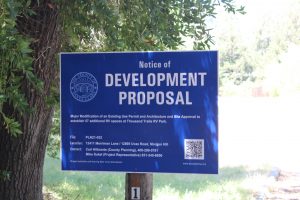RV parks must respect and abide by the Santa Clara County General Plan and the San Martin Integrated Design Plan.
![]()

Sign on edge of Thousand Trails property describing the proposed development of the RV park.
Photo by Chad Mays
By Connie Ludewig

Connie Ludewig
Because of the ever-mounting cost of living in Silicon Valley and desires to meet the need for affordable housing, considerations for mobile-housing have been increasingly steered toward establishing RV parks as a viable full-time residential solution. To many, it seemed to be the perfect concept . . . until thorough consideration was given to who was really driving this, and attention was devoted to the environmental concerns, lack of existing infrastructure (roads, schools, emergency services), and for the resulting plight of unincorporated Santa Clara County communities, including San Martin.
As proponents aimed toward the finish line, promoting this multi-family movable housing idea, without the knowledge or understanding of the Santa Clara County zoning guidelines, and Planning Department’s own analysis, the public would come to learn that RV parks have high-strength wastewater and are likely to result in groundwater contamination if they are permitted at significantly higher densities than what was ever envisioned for these areas. These limitations make high-density residential RV parks incompatible with the rural residential (RR) zoning district.
San Martin Neighborhood Alliance, a nonprofit organization, has been tracking the proposals of two RV parks: the San Martin RV Park (proposed for the northwest corner of Monterey Road and California Avenue) and the DiVittorio RV Park (proposed for the southeast corner of Middle and Seymour avenues). The latter is being proposed by the owners of the existing Maple Leaf RV Park in Morgan Hill.
 With a combined 395 spaces, the DiVittorio RV Park, proposed to be 270 spaces, and the San Martin RV Park, proposed to be 125 spaces, and an average of four people (two adults and two children) per RV, this represents an increase in San Martin’s population of 1580 people – an increase of 21 percent – without any increase in infrastructure (schools, sheriff, fire, roads, etc.). That would mean an additional 790 students in San Martin/Gwinn with no additional teachers. And none of these numbers include the Thousand Trail RV Park, that would be in addition to all the numbers just quoted.
With a combined 395 spaces, the DiVittorio RV Park, proposed to be 270 spaces, and the San Martin RV Park, proposed to be 125 spaces, and an average of four people (two adults and two children) per RV, this represents an increase in San Martin’s population of 1580 people – an increase of 21 percent – without any increase in infrastructure (schools, sheriff, fire, roads, etc.). That would mean an additional 790 students in San Martin/Gwinn with no additional teachers. And none of these numbers include the Thousand Trail RV Park, that would be in addition to all the numbers just quoted.
Also, while the owners can propose a partitioning of the park into permanent residents and transients, once the park is in place, it is the state, not the county, that controls that ratio and the park owners can petition the state to make a much higher percentage permanent and the county has absolutely no control.
 Now consider the financial motivation: according to a local RV park owner, their spaces rent for $1,100 to $1,400 per month – more if they rent the RV, too. For 270 spaces, that is $297,000 to -$378,000 per month. That translates to $3.5 million to $4.5 million income per year.
Now consider the financial motivation: according to a local RV park owner, their spaces rent for $1,100 to $1,400 per month – more if they rent the RV, too. For 270 spaces, that is $297,000 to -$378,000 per month. That translates to $3.5 million to $4.5 million income per year.
Although RV parks are a for-profit business, it is imperative that they respect and abide by the Santa Clara County General Plan, the San Martin Integrated Design Plan, and consider the health and welfare of our rural residential community.
At the Santa Clara County Board of Supervisors May 25 meeting, supervisors unanimously voted to approve the RV re-zoning ordinance and amendment changes that will take effect within 30 days. Additionally, San Martin RV Park has officially withdrawn their application.
SMNA wishes to acknowledge and thank our South County community for asking questions and voicing your concerns, for sending numerous letters to the supervisors and Planning Commission members, and for attending public hearings. Your support for the county’s General Plan and recommendation of Green Foothills, Open Space Authority, San Martin Planning Advisory Committee (SMPAC), and other groups, just goes to show that “Together we make a difference.”
Connie Ludewig is the vice president of the San Martin Neighborhood Alliance board of directors.






